Related Research Articles

HMS Speedy was a 14-gun Speedy-class brig of the British Royal Navy. Built during the last years of the American War of Independence, she served with distinction during the French Revolutionary Wars.
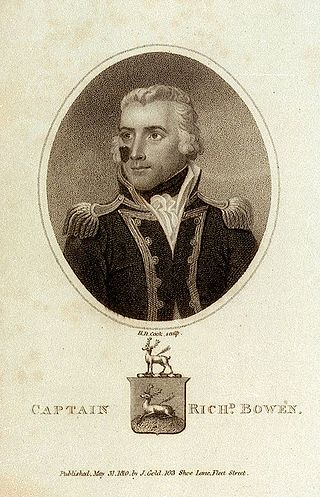
Richard Bowen was an officer of the Royal Navy who served during the American War of Independence and the French Revolutionary Wars. Bowen saw service with Horatio Nelson, and was killed fighting alongside him at the Battle of Santa Cruz de Tenerife.
Captain Temple Hardy was an English naval officer active during the French Revolutionary Wars. He commanded a battalion of sailors during the invasion of the Cape Colony in 1795.

Vice-Admiral George Byng, 6th Viscount Torrington, Royal Navy, commanded HMS Cumberland, the ship which returned King William I to the Netherlands from his exile in London, for which service he was appointed by the king to the Military Order of William.
Mignonne was an 18-gun Etna-class corvette of the French Navy, launched in 1795. She served until 1803 when the British captured her. Though she served briefly, there is no record of her actually being commissioned into the Royal Navy; she grounded and was condemned in 1804.
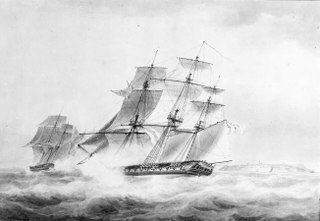
HMS Phoenix was a 36-gun Perseverance-class fifth-rate frigate of the Royal Navy. The shipbuilder George Parsons built her at Bursledon and launched her on 15 July 1783. She served in the French Revolutionary and Napoleonic Wars and was instrumental in the events leading up to the battle of Trafalgar. Phoenix was involved in several single-ship actions, the most notable occurring on 10 August 1805 when she captured the French frigate Didon, which was more heavily armed than her. She was wrecked, without loss of life, off Smyrna in 1816.
Admiral Sir John PooBeresford, 1st Baronet, was a Royal Navy admiral, Second Sea Lord and Conservative MP.

Rear-Admiral Sir Charles Cunningham KCH was an officer of the Royal Navy during the late eighteenth and early nineteenth century. He saw action during the American War of Independence and the French Revolutionary and Napoleonic Wars, eventually rising to the rank of rear-admiral.

James Richard Dacres was an officer of the Royal Navy who saw service during the Seven Years' War, the American War of Independence and the French Revolutionary and Napoleonic Wars. He eventually rose to the rank of Vice-Admiral.
Admiral Sir Robert Laurie, 6th Baronet KCB was an officer of the Royal Navy who served during the French Revolutionary and Napoleonic Wars. He rose through the ranks after his entry, fighting as a lieutenant under Howe at the Glorious First of June, and being wounded in the action. Shortly after he served in the West Indies and off the American coast, where he operated successfully against enemy raiders and privateers, he was rewarded with the command of the frigate HMS Cleopatra, and in 1805 fought an action with a superior French opponent, Ville de Milan. He was forced to surrender his ship after several hours of fighting, but so heavily damaged the Frenchman that both she and the captured British vessel were taken shortly afterwards when another British frigate HMS Leander, arrived on the scene. Rewarded for his valour and honourably acquitted for the loss of his ship, he served throughout the rest of the Napoleonic Wars. He rose to flag rank after the end of the wars, eventually dying in 1848 with the rank of Admiral of the White. He inherited a baronetcy in 1804, but this became extinct upon his death.
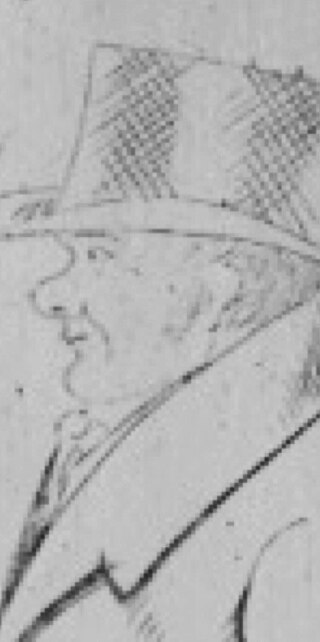
Rear-Admiral Samuel Sutton was an officer in the Royal Navy. He entered the service shortly after the start of the American War of Independence, and spent most of his early career serving with Captain and later Admiral Joshua Rowley. He saw action at several engagements with the French fleets in the West Indies, and ended the war as a lieutenant. Left without active employment by the following years of peace, Sutton briefly returned to service during the Spanish Armament in 1790, but the outbreak of the French Revolutionary Wars in 1793 brought him steady work. After serving in a number of ships and being present at Cornwallis's Retreat in 1795, Sutton received command of a sloop, and with it the opportunity to render a service to a member of the French aristocracy, and the future Charles X of France. Promoted for his good service, Sutton served as a flag captain to several admirals, including Horatio Nelson. He briefly commanded HMS Victory, before surrendering her to Thomas Hardy, who would go on to command Victory at Trafalgar, and be present at Nelson's death. Sutton instead took command of a frigate, and in 1804 was involved in a controversial action that saw the capture of three Spanish frigates and the destruction of a fourth. Made wealthy from the spoils, Sutton nevertheless remained in the navy, taking part in the chase of the French fleet to the West Indies in 1805. His health declined during this period, and he went ashore in October that year. He retired from active service, and served as a magistrate and local official for his community, being promoted to rear-admiral in 1821 and dying in 1832.

Sir William Hotham GCB was an officer of the Royal Navy who saw service during the French Revolutionary and Napoleonic Wars.
Admiral Sir Lawrence William Halsted GCB was an officer of the Royal Navy who served during the American War of Independence and the French Revolutionary and Napoleonic Wars.
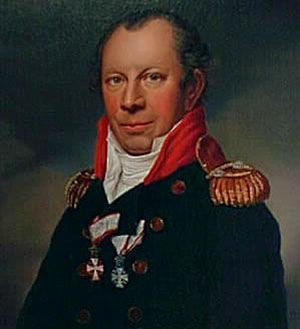
Carl Wilhelm Jessen was a Danish naval officer and Governor of St Thomas in the Danish West Indies.
Sir Henry Heathcote was an officer of the Royal Navy who served during the French Revolutionary and Napoleonic Wars.

Admiral John Markham, was a Royal Navy officer. As a junior officer he served in the American Revolutionary War. He commanded the third-rate HMS Hannibal in the action of 10 April 1795 and then the third-rate HMS Centaur, capturing a French frigate squadron in the action of 18 June 1799, during the French Revolutionary Wars. He went on to be a Lord Commissioner of the Admiralty and First Naval Lord under Earl St Vincent. He also served as MP for Portsmouth.

The action of 12 May 1796 was a minor naval engagement during the French Revolutionary Wars between a squadron of British Royal Navy frigates and a frigate and four smaller ships of the Batavian Navy. The British squadron had been detached on the previous day from the British North Sea fleet under Admiral Adam Duncan, which was cruising off the Batavian fleet anchorage at the Texel, while the Batavian squadron was returning to the Netherlands from the Norwegian coast where it had been sheltering since suffering defeat at the action of 22 August 1795 the previous year. As the Batavian squadron neared the Batavian coast, the British squadron under Captain Lawrence Halstead attacked.
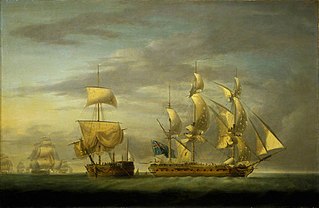
Admiral Sir George Parker, KCB was a British Royal Navy officer.
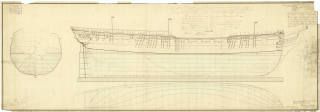
HMS Artois was a fifth-rate Artois-class frigate of the Royal Navy, designed by Sir John Henslow and launched in 1794 at Rotherhithe as the lead ship of her class. She served for the majority of her career in the English Channel under the command of Edmund Nagle in the squadrons of Edward Pellew and John Borlase Warren, notably taking part in the action of 21 October 1794 where she captured the 44-gun frigate La Révolutionnaire almost singlehandedly. She participated in a number of other actions and events including the attempted invasion of France in 1795. Artois continued to serve actively on the coast of France in blockade and patrolling roles, taking a large number of ships as prizes, until she was wrecked with no loss of life off Île de Ré on 31 July 1797 while attempting to reconnoitre the harbour of La Rochelle.
Admiral Thomas Le Marchant Gosselin was a British naval officer of the 18th and 19th centuries who received the patronage of senior officers such as Samuel Hood, 1st Viscount Hood and William Cornwallis. Gosselin joined the Royal Navy in 1778 and as a junior officer had extensive service in the American Revolution, including participating in the Battle of the Saintes in April 1782. Promoted to commander in April 1793, Gosselin took part in the Glorious First of June as commander of HMS Kingfisher. He was promoted to post-captain in July 1795 and took command of a variety of ships including most notably HMS Syren, HMS Latona, and HMS Audacious. Gosselin frequently served on blockade duties in the English Channel and on convoy duties to and from the West Indies.
References
- 1 2 Commissioned Sea Officers of the Royal Navy 1660-1815, vol. 3. ed. David Syrett
- ↑ Naval History of Great Britain, vol.1 p. 300 Archived 3 July 2019 at the Wayback Machine
- ↑ Despatches of Major-General Craig, 21 September 1795. Printed in The Times, 25 November 1795
- ↑ Despatches of Admiral Elphinstone, 23 September 1795. Printed in The Times, 25 November 1795
- ↑ The Universal Scots almanack, for the year 1800. Robert Allan, Edinburgh. 1800. Online extract
- ↑ Despatches of Rear-Admiral Thomas Pringle, 15 January 1797. Printed in The Times, 5 April 1797
- ↑ STATELY (64)
- ↑ Sailing ships of the Royal Navy, A1 Archived 9 October 2006 at the Wayback Machine
- ↑ "HM Ships employed on cruising duty - May 1805". Archived from the original on 27 August 2006. Retrieved 4 October 2006.
- ↑ Survey of the career of Frederick Franks [ permanent dead link ]
- ↑ Naval History of Great Britain, vol.5 p. 146 Archived 6 November 2006 at the Wayback Machine
- ↑ Sailing ships of the Royal Navy, V [ permanent dead link ]
- ↑ Sailing ships of the Royal Navy, B1 Archived 9 October 2006 at the Wayback Machine
- ↑ The Gentleman's Magazine, January 1822 p. 284
- ↑ Will of John William Spranger, Rear Admiral in His Majesty's Navy at the National Archives, catalogue reference PROB 11/1657